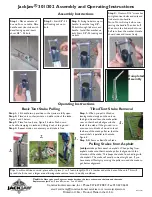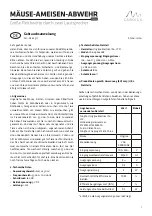
4
3.1 Handling
To hoist the blower, use a cable as
shown in fig. 3
WARNING: Do not use the holes in the
flanges to lift the blower.
3.2 Storage
Keep the blower in a dry cool closed environment. Do not remove the protective coverings placed
over the blower openings. Rotate blower shaft 2-3 complete turns every 6 months. Renew the
preservation every 6 months, or more frequently if the climate is damp.
3.2.1 Bearing storage –
Half fill the sumps with anti-rust oil. Manually rotate the blower shaft.
Dispose of the used oil in accordance with local regulations.
3.2.2 Preservation of the compression chamber –
Remove the protective coverings from the
blower openings. Apply a thin film of anti-rust oil to the internal surfaces of the body, covers and
the rotor surfaces.
WARNING:
Use anti-rust and foam inhibiting oil with fire point over 392ºF (200ºC) only.
4.1 On-site positioning of blower
The blower has to be set horizontally on a level surface and attached using bolts which secure the
feet or the outlet flange. Place shims under feet of blower to prevent overstressing of the housing.
4.2 Coupling
4.2.1 Direct coupling –
Slide the half couplings onto the shaft of the blower and of the motor
using suitable tools.
•
Align the shafts of the blower and of the motor and, where necessary insert shims under the feet
of the motor and/or blower.
•
Check the alignment by using calipers or gauges as per coupling manufacturer’s specifications.
WARNING:
Do not use a hammer to slide on the half couplings.
4.2.2 Belt drive coupling –
Use suitable equipment to mount the sheaves onto the blower and
motor shafts. The minimum blower sheave diameters are shown in
Table IV
– see page 5.
Mount the drive belts. Belt tension is produced by using the motor thrust screws in accordance
with the values shown in
Table V
– see page 6. During this phase, the alignment of the sheaves
must be checked using a scale resting against the sheaves as shown in figure 5 – see page 6.
WARNING:
Do not use a hammer to mount the sheaves.
WARNING:
Excessive belt tension could damage the blower and the motor.
Secure the feet of the motor.
Horizontal: /H
Vertical: /V
Fig. 3
Blower Engineering Instructional Manual
Содержание Tri-Lobe TL Series
Страница 1: ......







































